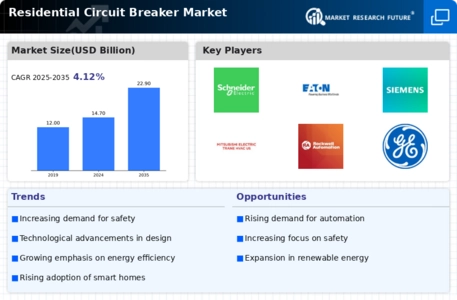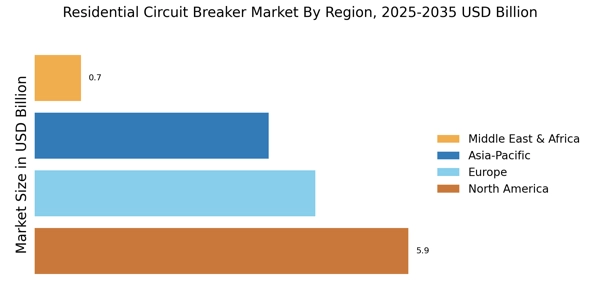Increased Focus on Home Safety
The heightened awareness regarding home safety is a pivotal driver for the Residential Circuit Breaker Market. Homeowners are increasingly prioritizing safety features in their electrical systems, leading to a surge in demand for high-quality circuit breakers. Regulatory bodies are also enforcing stricter safety standards, compelling manufacturers to innovate and improve their product offerings. Data from safety organizations indicates that homes equipped with modern circuit breakers experience fewer electrical hazards, which further propels consumer interest. As a result, the market for residential circuit breakers is likely to expand, with a focus on products that meet or exceed safety regulations, thereby enhancing the overall safety of residential electrical systems.
Government Initiatives and Incentives
Government initiatives aimed at promoting energy efficiency and safety are significantly impacting the Residential Circuit Breaker Market. Various programs and incentives encourage homeowners to upgrade their electrical systems, including circuit breakers, to meet modern standards. These initiatives often include financial incentives for adopting energy-efficient technologies, which can lead to increased sales of advanced circuit breakers. Recent data indicates that regions with active government programs see a higher rate of circuit breaker upgrades, suggesting that such initiatives play a crucial role in market dynamics. As governments continue to advocate for improved electrical safety and efficiency, the Residential Circuit Breaker Market is likely to benefit from increased consumer participation and investment.
Rising Demand for Renewable Energy Sources
The increasing emphasis on renewable energy sources is driving the Residential Circuit Breaker Market. As households adopt solar panels and wind turbines, the need for reliable circuit breakers that can handle variable power inputs becomes crucial. This shift towards sustainable energy solutions is expected to boost the demand for advanced circuit breakers that ensure safety and efficiency. According to recent data, the residential sector is projected to witness a significant rise in renewable energy installations, which will likely necessitate upgrades in circuit protection devices. Consequently, manufacturers are focusing on developing circuit breakers that are compatible with renewable energy systems, thereby enhancing their market presence in the Residential Circuit Breaker Market.
Urbanization and Infrastructure Development
Urbanization is a significant factor influencing the Residential Circuit Breaker Market. As more individuals move to urban areas, the demand for residential housing increases, leading to a corresponding rise in electrical installations. This trend necessitates the use of reliable circuit breakers to ensure the safety and efficiency of electrical systems in new homes. Market analysis suggests that urban areas are experiencing a construction boom, with a notable increase in residential projects. Consequently, this growth in infrastructure development is expected to drive the demand for circuit breakers, as builders and homeowners seek to comply with safety standards and enhance the reliability of their electrical systems in the Residential Circuit Breaker Market.
Technological Advancements in Circuit Breakers
Technological innovations are reshaping the Residential Circuit Breaker Market. The introduction of smart circuit breakers, which offer features such as remote monitoring and automated fault detection, is gaining traction among consumers. These advancements not only improve safety but also enhance energy management in residential settings. Market data indicates that the adoption of smart technology in circuit breakers is expected to grow at a compound annual growth rate of over 10% in the coming years. This trend suggests that manufacturers who invest in research and development of smart circuit breakers may capture a larger share of the Residential Circuit Breaker Market, appealing to tech-savvy homeowners seeking enhanced control over their electrical systems.


















Leave a Comment